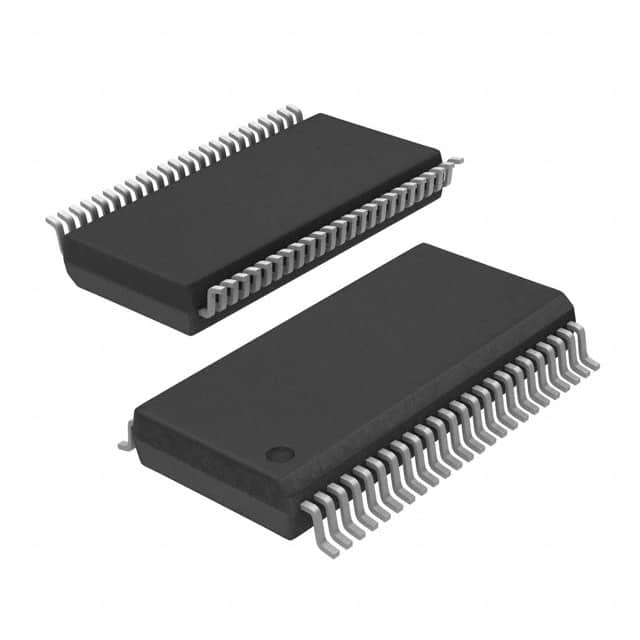Lihat spesifikasi untuk detail produk.

74LVTH162245DLRG4
Basic Information Overview
- Category: Integrated Circuit (IC)
- Use: Level Shifter and Buffer/Driver
- Characteristics: High-speed, low-voltage, and low-power consumption
- Package: TSSOP (Thin Shrink Small Outline Package)
- Essence: Transceiver
- Packaging/Quantity: Tape and Reel, 2500 pieces per reel
Specifications
- Logic Family: LVTH
- Number of Channels: 16
- Input Voltage Range: 1.2V to 3.6V
- Output Voltage Range: 1.2V to 3.6V
- Operating Temperature Range: -40°C to +85°C
- Supply Voltage Range: 1.2V to 3.6V
- Output Current: ±12mA
- Propagation Delay Time: 2.5ns (typical)
Detailed Pin Configuration
The 74LVTH162245DLRG4 has a total of 48 pins, arranged in a TSSOP package. The pin configuration is as follows:
___________
OE1 -| 1 48 |- VCC
GND1 -| 2 47 |- GND2
A1_1 -| 3 46 |- B1_1
A2_1 -| 4 45 |- B2_1
A3_1 -| 5 44 |- B3_1
A4_1 -| 6 43 |- B4_1
A5_1 -| 7 42 |- B5_1
A6_1 -| 8 41 |- B6_1
A7_1 -| 9 40 |- B7_1
A8_1 -|10 39 |- B8_1
A9_1 -|11 38 |- B9_1
A10_1 -|12 37 |- B10_1
A11_1 -|13 36 |- B11_1
A12_1 -|14 35 |- B12_1
A13_1 -|15 34 |- B13_1
A14_1 -|16 33 |- B14_1
A15_1 -|17 32 |- B15_1
A16_1 -|18 31 |- B16_1
GND3 -|19 30 |- VCC
OE2 -|20 29 |- GND4
GND5 -|21 28 |- GND6
A1_2 -|22 27 |- B1_2
A2_2 -|23 26 |- B2_2
A3_2 -|24 25 |- B3_2
‾‾‾‾‾‾‾‾‾‾‾‾
Functional Features
- Bidirectional level shifting between two voltage domains
- High-speed data transmission with low propagation delay
- Wide operating voltage range for compatibility with various systems
- Output enable (OE) pins for controlling the direction of data flow
Advantages and Disadvantages
Advantages: - High-speed operation allows for efficient data transfer - Low-voltage operation reduces power consumption - Bidirectional functionality simplifies system design
Disadvantages: - Limited output current may not be suitable for driving heavy loads - TSSOP package may require careful handling during assembly
Working Principles
The 74LVTH162245DLRG4 is a bidirectional level shifter and buffer/driver. It allows for the translation of logic signals between two voltage domains, typically between a low-voltage system and a higher-voltage system. The IC operates by receiving input signals from one domain and converting them to the appropriate voltage levels for the other domain. The direction of data flow can be controlled using the output enable (OE) pins.
Detailed Application Field Plans
The 74LVTH162245DLRG4 is commonly used in various applications that require level shifting and buffering between different voltage domains. Some typical application fields include: - Communication systems - Data acquisition systems - Industrial automation - Consumer electronics - Automotive electronics
Detailed and Complete Alternative Models
- SN74LVTH162245DGGR
- MC74LVTH162245DG
- 74LVTH162245MTDX
These alternative models offer similar functionality and specifications to the 74LVTH162245DLRG4 and can be considered as alternatives based
Sebutkan 10 pertanyaan dan jawaban umum terkait penerapan 74LVTH162245DLRG4 dalam solusi teknis
Sure! Here are 10 common questions and answers related to the application of 74LVTH162245DLRG4 in technical solutions:
Q: What is the 74LVTH162245DLRG4? A: The 74LVTH162245DLRG4 is a 16-bit bus transceiver with 3-state outputs, designed for low-voltage (3.3V) applications.
Q: What is the maximum operating frequency of the 74LVTH162245DLRG4? A: The maximum operating frequency of the 74LVTH162245DLRG4 is typically around 200 MHz.
Q: Can the 74LVTH162245DLRG4 be used for level shifting between different voltage domains? A: Yes, the 74LVTH162245DLRG4 can be used for level shifting between 3.3V and other voltage domains, such as 5V.
Q: How many data inputs and outputs does the 74LVTH162245DLRG4 have? A: The 74LVTH162245DLRG4 has 16 data inputs and 16 data outputs.
Q: Does the 74LVTH162245DLRG4 support bidirectional data transfer? A: Yes, the 74LVTH162245DLRG4 supports bidirectional data transfer, allowing data to flow in both directions.
Q: What is the power supply voltage range for the 74LVTH162245DLRG4? A: The power supply voltage range for the 74LVTH162245DLRG4 is typically between 2.7V and 3.6V.
Q: Can the 74LVTH162245DLRG4 handle high-speed data transmission? A: Yes, the 74LVTH162245DLRG4 is designed to handle high-speed data transmission with minimal delay and skew.
Q: Does the 74LVTH162245DLRG4 have built-in ESD protection? A: Yes, the 74LVTH162245DLRG4 has built-in ESD protection, which helps protect against electrostatic discharge.
Q: Can the 74LVTH162245DLRG4 be used in automotive applications? A: Yes, the 74LVTH162245DLRG4 is qualified for automotive applications and meets the necessary standards.
Q: What package options are available for the 74LVTH162245DLRG4? A: The 74LVTH162245DLRG4 is available in various package options, such as TSSOP and TVSOP, to suit different design requirements.
Please note that the answers provided here are general and may vary depending on specific datasheet specifications and application requirements.

